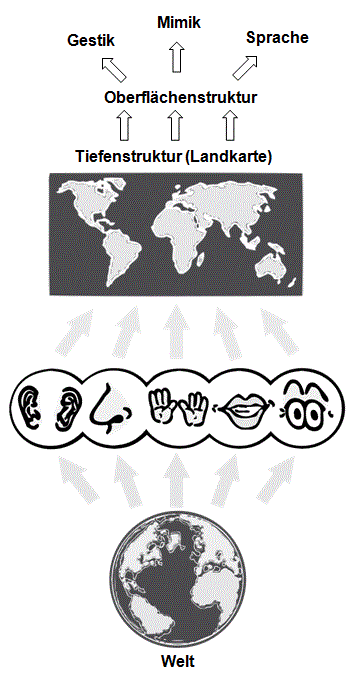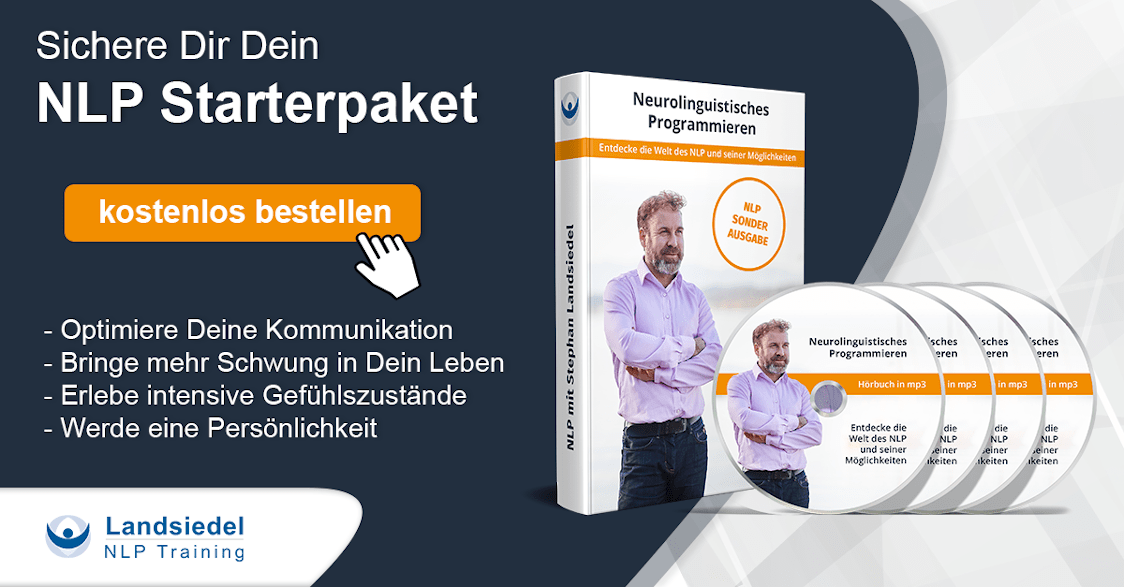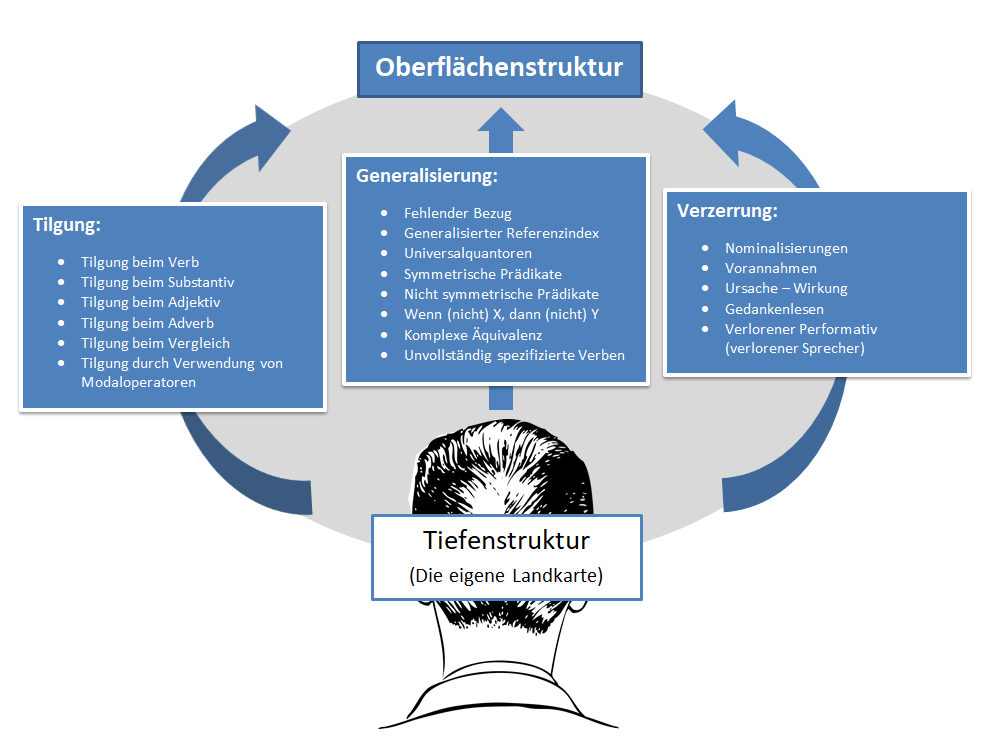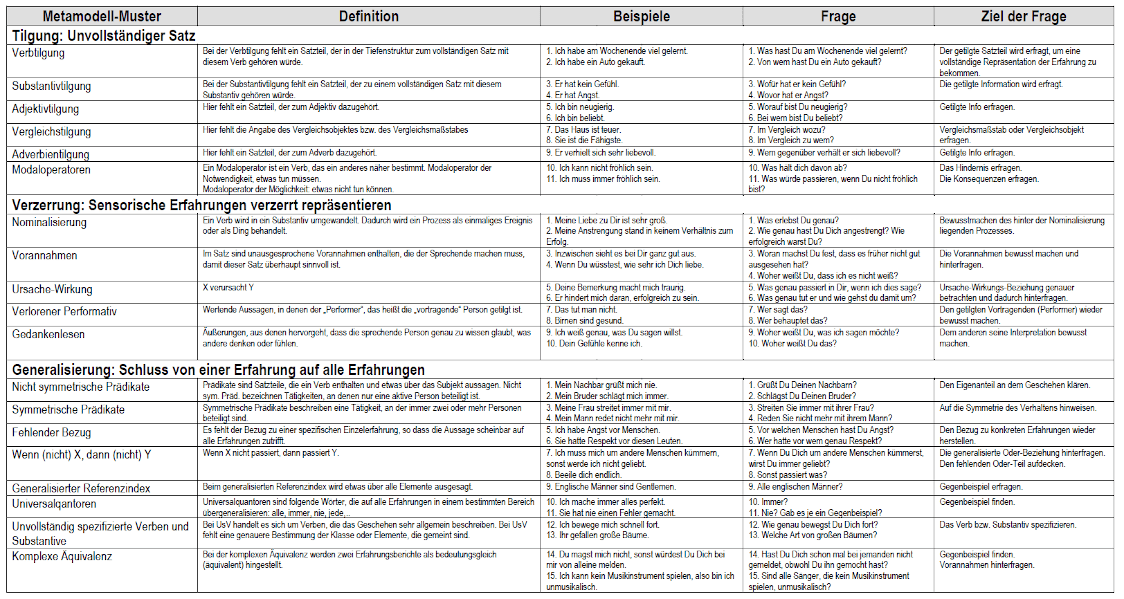The Meta Model of Language
Become aware of the magic of your language. It is not only the basis of clear communication but also a tool for fast and focused change. With this NLP technique, you will master one of the most powerful linguistic tools of our time and become a true master of spoken language.
Table of Contents
- What is the Meta Model?
- Recovering Lost Information
- Meta Model Violations
- Meta Model Language Patterns
- Meta Model Pattern Overview Table
- Beware of the Meta Model Monster!
What is the Meta Model?

Misunderstandings in communication happen every day. They are a part of life. Often, they are based on a false assumption: people assume they have understood each other correctly about a certain topic — when in fact they haven’t. In conversation, people communicate based on their own background of experience. Problems arise when the listener has a different frame of reference than the speaker. When important information is omitted — information the speaker assumes is “obvious” — this can lead to a sender-receiver problem.
Common language patterns that lead to misunderstandings are deletions, generalizations, and distortions. The Meta Model provides a way to question and clarify these ambiguities. It consists of a series of questions designed to uncover the deeper structure underlying surface-level statements.
Goal: The Meta Model helps recover lost information and better understand relationships and meanings in communication.
Recovering Lost Information

When we speak, we often leave out, generalize, or distort information. The message sent often doesn’t fully match the intended message, which causes misunderstandings. Therefore, it’s necessary to recover the lost information.
When sharing experiences, we consciously or unconsciously select only parts of the full experience to communicate. This full experience is called the “deep structure,” while the simplified version we actually say is the “surface structure.” This allows us to communicate efficiently without recounting every detail. However, this process also shapes how we interpret experiences and assign meaning to them.
Especially when facing problems, our filtering process tends to limit our experiences and perceptions, causing us to lose valuable information. These verbal results of filtering are called Meta Model violations — sentences where meaning or information is missing, generalized, or distorted.
The Meta Model provides tools to challenge these processes. By asking specific questions, we can regain precise and complete information about what the speaker actually means, restoring the connection between language and full experience.
Introducing Meta Model Violations
The following sections illustrate the three main processing patterns — deletion, generalization, and distortion — with clear explanations and examples.
Deletion
I am Deletion. I like to keep most information to myself — the black hole of language. Everyone fills in the blanks differently. I love leaving things out; brevity is my motto. My human appreciates me because I help them focus on what seems essential and avoid overload. But sometimes I drive them crazy — when they need understanding but I strip context away. That’s when the Meta Model questions come to the rescue!
Generalization
I am Generalization. I see the world in black and white, always or never, all or none. Rules are my comfort zone. I help humans learn from experience, but I also make them rigid and blind to exceptions. When someone says “People never change,” that’s me speaking. Thankfully, Meta Model questions can loosen my grip!
Distortion
I am Distortion — the rose-colored glasses of lovers, the dark cloud of the moody. I twist reality to make sense of things, but sometimes I trap people in false logic. I let them think they know what others mean or feel — but often, they don’t. Meta Model questions expose my tricks and open the way to clearer understanding.

Language Patterns of the Meta Model
The classification of language patterns below follows the original work “The Structure of Magic I” by Richard Bandler and John Grinder. Other sources sometimes use slightly different categorizations — in true NLP spirit, there is no absolute “right” or “wrong.”

Deletion
Simple deletions indicate that the speaker has left out some elements of their experience representation and does not communicate them to the listener. Whether consciously or unconsciously, the result is that the listener lacks this information. When the listener notices the deletion, they can question it and gradually uncover more of the deep structure.
The most important deletions refer to the following elements:
| People: | Who did something? |
| Object: | To whom or to what was something done? |
| Place: | Where did something happen? |
| Time: | When did it happen? |
| Method: | How was it done? |
| Options: | What alternatives were there? |
| Quantity: | How often? How much? |
These pieces of information are needed to reconstruct the context in which experiences were made and the incomplete model was formed.
Deletion in Verbs
A part of the sentence belonging to the verb is missing.
Verbs can combine with several elements. Some are essential for grammatical correctness, others optional but potentially meaningful for the listener.
Example: <She> gives <me> <the bicycle> <tomorrow> <in town>.
For the verb “give,” we must specify who gives, what is given, and to whom. The rest — when and where — is optional. Grammatically, “She gives me the bicycle” is still correct.
Deletions can be clarified with questions like:
About what? With what? To whom? Exactly what? With whom? How much? In what way?
| Example | Question |
|---|---|
| I’m happy. | About what are you happy? |
| Peter is afraid. | Afraid of what? |
| My brother laughed. | What did he laugh about? |
| I bought a bike. | From whom did you buy it? |
Deletion in Nouns
Part of the sentence needed to make the noun meaningful is missing.
| Example | Question |
|---|---|
| Susanne has no idea. | About what? |
| He has no time. | For what? |
| I have a problem. | A problem with whom or what? |
| The dog is scared. | Scared of what or whom? |
Deletion in Adjectives
Adjectives describe nouns (e.g., tall, blue, round, brave). Adjectives always signal a deletion — the person who makes that evaluation is missing.
| Example | Question |
|---|---|
| He is respected. | By whom? |
| This man is successful. | In what? |
| The news is sad. | Sad for whom? |
| The noise is disturbing. | Disturbing to whom? |
Deletion in Adverbs
Adverbs describe how something is done. In this case, the sentence lacks an element that specifies “for whom” or “in what context.”
| Example | Question |
|---|---|
| He behaved appropriately. | Toward whom? |
| Obviously, that’s a problem. | Obvious to whom? |
| Unfortunately, nothing can be done. | Unfortunate for whom? |
| He argued aggressively. | With whom? |
Deletion in Comparisons
The reference point or standard for comparison is missing. For instance, in “The task is more difficult,” the listener doesn’t know — more difficult than what?
The Meta Model question: “Compared to what?”
| Example | Question |
|---|---|
| The tie was expensive. | Expensive compared to what? |
| Carl Lewis is the fastest. | Fastest in relation to what? |
| The tasks are harder. | Harder than what? |
| I prefer that. | Prefer it to what? |
Deletion through Modal Operators
Modal operators include: must, should, can, may, have to, allowed to, possible, impossible. They often point to hidden generalizations.
| Example | Question |
|---|---|
| I must do my homework. | What happens if you don’t? |
| We can’t be late. | What happens if you are? |
| You should listen to me. | What if I don’t? |
| We can’t make it. | What stops you? |
| No one can get rich in a year. | What makes that impossible? |
| You may not have more than one wife. | What prevents you from doing so? |
| I’m unable to solve this problem. | What keeps you from solving it? |
Distortion
Distortion happens when experiences are modified, often limiting a person’s perception and freedom of action. It occurs when new events are interpreted through old beliefs or beliefs, creating misleading cause-effect relationships.
Nominalizations
A process is turned into a static noun (e.g., “decision” from “decide”). Nominalizations make change seem impossible — but by turning them back into processes, we regain flexibility.
| Example | Question |
|---|---|
| My decision not to take the job weighs on me. | What stops you from deciding differently? |
| I’m full of hope. | Hope for what? |
| My conviction hasn’t changed. | Conviction about what? |
| The frustration is too much for her. | What is she frustrated about? |
Presuppositions
Presuppositions are assumptions embedded in statements that must be true for the sentence to make sense. Meta Model questions help reveal and challenge them.
| Example | Question |
|---|---|
| If you’re rude again, I won’t go out with you. | What exactly seemed rude? |
| You’ve made progress by now. | How do you know I wasn’t good before? |
| If you become smarter, you’ll understand my decision. | What makes you think I’m not smart? |
| You’re just as selfish as your father. | What makes you believe my father is selfish? |
Cause and Effect
The speaker assumes that another person or an external event causes their internal state — a loss of personal responsibility.
| Example | Question |
|---|---|
| You make me angry. | How exactly do I make you angry? |
| You depress me. | How exactly do I depress you? |
| I’m sad because you forgot me. | If I hadn’t forgotten you, would you still be sad? |
Mind Reading
This occurs when someone claims to know another person’s thoughts or feelings without evidence.
| Example | Question |
|---|---|
| I know exactly what you’re thinking. | How do you know? |
| If you loved me, you’d do what I expect. | How do you know what I expect? |
| I know what’s best for you. | How exactly do you know that? |
Lost Performative
A statement about a rule sounds universal, but the source (who said it) is missing.
| Example | Question |
|---|---|
| It’s wrong to kill people. | Who says that? |
| That’s not done. | Who says so? |
| Too much work makes you sick. | How do you know? |
Generalization
We generalize to simplify life — but sometimes we overdo it. Statements like “You never listen!” or “Everyone ignores me!” erase important details and exceptions. Meta Model questions bring those details back.
Missing Reference
The reference to a specific experience is missing. The nouns are vague or replaced by pronouns.
| Example | Question |
|---|---|
| No one listens to me. | Who exactly doesn’t listen? What do you say? |
| We don’t want to get lost in details. | Who exactly doesn’t want to? |
Universal Quantifiers
Words like “always,” “never,” “everyone,” “no one,” “nothing,” “all” create sweeping generalizations. You can question them directly or exaggerate them humorously.
| Example | Question |
|---|---|
| No one cares about me. | Really no one? Ever? |
| All people are bad. | All of them? No exceptions? |
Symmetrical Predicates
These describe mutual actions (e.g., “argue,” “fight”). Both parties are involved.
| Example | Question |
|---|---|
| Hans always argues with me. | Do you argue with Hans? |
| She never shakes my hand. | Do you offer your hand? |
If (not) X, then (not) Y
These statements assume false cause-effect relationships.
| Example | Question |
|---|---|
| I have to perform well so people like me. | Do you like others only when they perform well? |
| If I don’t love others, no one will love me. | If you love others, do they always love you back? |
Meta Model Pattern Overview Table
Click the image to enlarge.

Beware of the Meta Model Monster!
The Meta Model is incredibly powerful for uncovering the deep structure of thoughts and behaviors. But — not every question is helpful. NLP training teaches 22 questioning techniques, and not all are needed at once. True mastery means knowing when to ask which question — and when to stay silent. Use the Meta Model wisely, not monstrously!
Continue reading:

 Deutsch
Deutsch English
English Français
Français 中文
中文 Español
Español नहीं
नहीं Русский
Русский